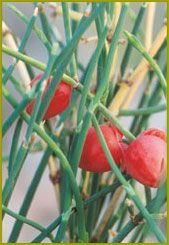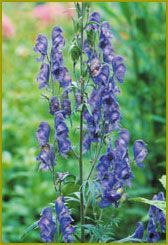NEW ORLEANS—Traditional Chinese medicine holds a vast pharmacopeia of herbs, minerals, animal tissues and other natural products. But in the US, only a small number are in widespread use outside of Chinese immigrant communities.
Michael Arnold, MD, a Pacific Grove, CA, pediatrician who now practices exclusively as a Chinese herbalist, said there are six Chinese herbs with which every physician should be familiar. “You will see these in your practice—if you ask,” Dr. Arnold told attendees at the annual meeting of the American Academy of Medical Acupuncture.
The more you know about these herbs, the more you can counsel curious patients. Under the guidance of an intelligent, experienced herbalist, “taking TCM herbs is much safer than getting in your car to buy them,” Dr. Arnold joked.
 |
|
| Ephedra (Ephedra sinica) known as Ma huang, should not be used as a weightloss agent. © 2000 stevenfoster.com. |
• EPHEDRA (Ma Huang): This is used widely by Chinese practitioners, often to treat asthma or induce sweating. But unlike the common pattern in the US, Chinese herbalists almost never use it as a single agent, and certainly do not use it for weight loss. “Here, it is sold like ‘herbal caffeine.’ You can get it at truck stops and 7-11s. It is just like speed, and there are reports of adverse events when people have taken it for the ‘buzz,’ or for weight loss.”
Ephedra can induce hypertension, restlessness, tremors, tachycardia, palpitations and insomnia. Though it is a stimulant, classical Chinese medicine does not recommend it to treat fatigue; if the fatigue is due to an energy deficiency of some sort, a stimulant like ephedra will only exacerbate the depletion. In general, this herb is for short-term use only.
Nearly all reported problems with ephedra reflect improper use without guidance. Under proper supervision, it is an effective herb for asthma. It is also a “warming” herb according to Chinese medical theory, used when “coldness” of some sort is at the root of a diagnosis. Unfortunately, it is easier for regulators to blame the herb—and ban it, as several states have done—than address the more difficult challenge of fostering more intelligent use of Chinese medicines.
 |
|
| Aconite (Aconitum napellus), known as Fu Zi, is a useful “hot” herb, but can be cardiotoxic if improperly prepared. © 2000 stevenfoster.com. |
• ACONITE (Fu Zi): Also called Wu Tou, Chan Wu or Cao Wu, this is a very important “hot” herb, found in many classical Chinese formulas. It is beneficial whenever someone has symptoms reflecting severe “cold” according to Chinese diagnosis. This includes certain types of arthritic pain.
Unfortunately, this root is also one of the most common causes of toxicity associated with Chinese herbs in the West. Raw aconite is very cardiotoxic and must be boiled for at least one hour before it can be used. Some case reports of toxicity may be due to improper preparation. Aconite also has a very narrow therapeutic window; the toxic dose is just a bit higher than the therapeutic dose.
Aconite can induce cardiac arrhythmias, which are sometimes fatal, as well as lightheadedness, blurred vision, nausea, numbness, and in extreme cases, stupor, dyspnea and incontinence. “This herb should be available by prescription of a qualified Chinese herbalist only. But it should not be banned because it is very useful,” Dr. Arnold stressed.
• ASTRAGALUS (Huang Qi): Widely promoted as an immune system builder, this herb in Chinese medicine is used to raise “Qi” or life energy, and move it from deep levels in the body out to the surface. While it can enhance athletic performance and increase immunity in some patients, it should not be used simplistically to “prevent colds” or other common ailments.
Astragalus can induce hypertension, agitation and insomnia, headache, tinnitus, dizziness and palpitations. Since it tends to push energy upward and outward, it can exacerbate rather than attenuate various types of pain including headache. Dr. Arnold said that it can also make acne worse.
• LICORICE (Gan Cao): This is by far the most commonly used herb in Chinese medicine; owing to its sweetish nature, it is the proverbial “spoonful of sugar” to help other medicines go down. Licorice is used in small amounts in many classical formulas as a “harmonizer” to help other herbs work together and to attenuate potential adverse effects of some of the stronger herbs in a formula.
Chemically, licorice has a mineralocorticoid effect, not unlike aldosterone. It can reduce urine output, decrease sodium excretion and increase potassium excretion. Theoretically, it can cause hypertension and edema. In practice, this is very rare, because the amount of licorice in Chinese formulations is usually very small. Overall, this is a very safe herb.
• PANAX GINSENG (Ren Shen): Without doubt, one of the most widely used Chinese herbs in America, panax ginseng has a popular reputation as an energy booster, immune system enhancer, and a quick fix for fatigue. But without a careful Chinese diagnosis, use of a strong tonic like ginseng is a dice-roll: it will work for some people but an equal number will not benefit.
Some patients may even have adverse effects, including hypertension. Tonic herbs like ginseng can exacerbate headaches, insomnia and rashes. They can also be relatively difficult to digest, resulting in constipation, loss of appetite, and other gastrointestinal discomforts—a symptom pattern Dr. Arnold referred to as “tonic tummy.”
Be aware that “Red Ginseng” is different from panax ginseng. The latter is naturally whitish; “red” ginseng has been processed with aconite (see above) to intensify the warming nature of ginseng. The aconite confers the red color. A patient taking “red” ginseng will likely be getting a significant dose of aconite as well. This is probably not good for patients with cardiovascular problems.
• RHUBARB ROOT/RHIZOME (Da Huang): This is a common purgative in Chinese medicine, given for diagnoses related to “excess heat” and “blood stagnation,” which can manifest in some cases of constipation. While it is generally safe, it can cause abdominal pain, cramping and diarrhea. Because it has a laxative effect, there is some potential for abuse in patients who have histories of laxative overuse. Rhubarb is another herb that must be boiled for at least one hour to reduce its potential toxicity.
Many of the minerals and animal products used in Chinese medicine are seldom seen outside Asian communities, but Dr. Arnold said there is one non-herbal substance about which all physicians should be aware:
• CINNABAR (Zhu Sha): Cinnabar is commonly used in China as a sedative. But it contains mercuric sulfide, and easily releases elemental mercury if heated. Consequently, it can cause neurologic symptoms of mercury poisoning, and there are case reports in the literature of such occurrences. There is little rationale for use of cinnabar in the US; there are many good alternatives for sedation—herbal or otherwise. But it is important to be aware of it, since it is a fairly common ingredient in patent medicines imported from China or other Asian countries.







